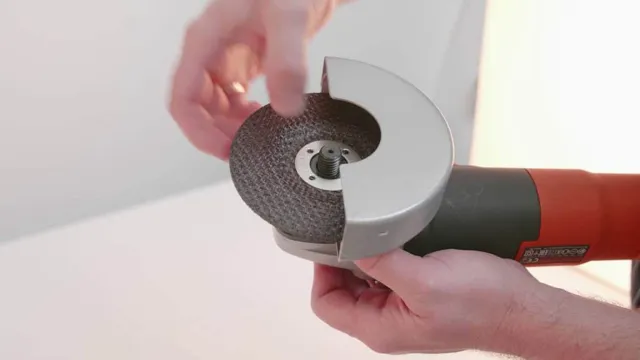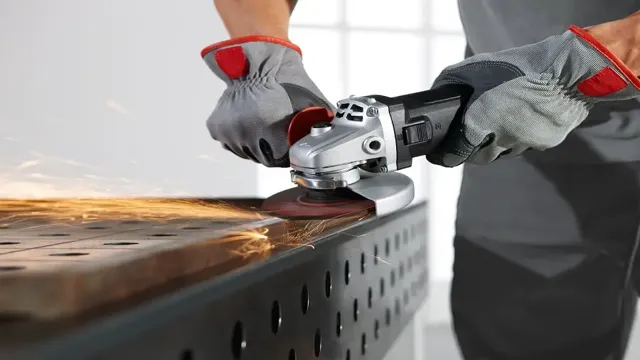Can an Angle Grinder Cut Through Steel? Tips and Tricks for Precision Cuts

An angle grinder is one of the most versatile and powerful tools in any handyman’s arsenal. It is an incredibly potent chunk of machinery that can cut through various materials like a hot knife through butter. But have you ever wondered if an angle grinder can cut through steel? Well, the short answer is yes! But, there’s more to it than just that simple answer.
This tiny powerhouse of a device is used by many professionals and DIY enthusiasts alike, and it’s no surprise why. Its ability to cut through almost anything makes it a popular choice in workshops and worksites. However, steel is one of the toughest and most challenging materials to work with, and you might be hesitant to use an angle grinder to cut through it.
If you’re wondering how an angle grinder can achieve this feat, then this blog will provide you with all the information you need to know. We’ll explore the essential factors you must consider when cutting through steel, how to prepare and use the angle grinder to achieve optimal results. So, whether you’re a professional welder looking for a quick way to cut through heavy-duty steel or a DIY enthusiast looking to sharpen your skills, keep reading to find out if an angle grinder is the right tool for the job!
Understanding Angle Grinders
If you’re wondering whether an angle grinder can cut through steel the answer is yes! Angle grinders are versatile tools that can cut through a wide range of materials, including steel. However, it’s important to choose the right blade for the job. Using a blade that is too small or not designed for cutting through steel can cause problems, including increased wear and tear on the tool, kickback, and potentially dangerous situations.
It’s important to use a high-quality blade specifically designed for cutting through steel, and to make sure it is securely attached to the tool. With the right blade and proper technique, an angle grinder can easily cut through steel pipes, metal sheets, and other steel materials. Remember to wear safety gear, such as eye protection and gloves, when using an angle grinder.
What is an Angle Grinder?
An angle grinder is a versatile tool commonly used in construction, metalworking, and other DIY projects. This handheld device features a motor and a rotating abrasive disc, attached to a spindle. Angle grinders come in different sizes, power levels, and disc types, allowing users to cut, grind, polish, and shape various materials, such as metal, concrete, tiles, and wood.
Although angle grinders are simple to operate, they pose some safety risks, especially when used incorrectly or without proper equipment and precautions. It’s essential to read the user manual, wear protective gear, and follow the proper techniques and safety protocols when using an angle grinder. Whether you need to remove rust, sharpen blades, or cut through thick materials, an angle grinder is a handy and efficient tool that anyone can use with the right knowledge and practice.

Types of Angle Grinders
Angle grinders are versatile power tools that can be used for various cutting and grinding applications. There are two types of angle grinders available in the market: corded and cordless. Corded angle grinders are powered by electricity and have a constant source of power.
On the other hand, cordless angle grinders are battery-powered and are perfect for outdoor applications. Depending on the application, angle grinders can come with different disc sizes ranging from 5 inches to 9 inches.
Smaller size discs can be used for intricate detail work, while larger discs are ideal for heavy-duty metal cutting and grinding tasks. It is important to choose the right type and size of angle grinder depending on the task at hand for a safe and efficient job.
Choosing the Right Blade for Cutting Steel
Angle grinders are versatile tools that can be used for a variety of cutting and grinding tasks, including cutting steel. However, choosing the right blade for your angle grinder can make all the difference when it comes to getting the job done quickly and efficiently. When selecting a blade for cutting steel, it is important to consider the thickness of the steel you will be cutting, as well as the type of cut you want to make.
For thicker steel, a diamond blade is usually the best option, as it is strong enough to cut through even the toughest metals. However, for thinner steel, a cut-off or grinding wheel may be more appropriate. It is also important to choose a blade with the appropriate diameter for your angle grinder, as a blade that is too large or too small can be dangerous to use.
By understanding the different types of angle grinder blades available and choosing the right one for your needs, you can ensure that your cutting tasks are completed quickly, efficiently, and safely.
Cutting Through Steel with an Angle Grinder
If you’re in need of cutting through steel, an angle grinder can indeed be an effective tool to get the job done. With its spinning disc and powerful motor, an angle grinder can smoothly slice through steel like a hot knife through butter. However, it’s important to choose the right disc for the job – diamond discs are ideal for cutting through hard metals, while grit discs can be more effective on softer metals.
It’s also crucial to wear proper protective gear, including eye and ear protection, gloves, and long sleeves. While an angle grinder can be a powerful tool in cutting through steel, it’s essential to use it with caution and respect the equipment’s power.
Safety Precautions to Consider
Cutting through steel with an angle grinder can be a challenging task. However, with the right safety precautions, it can be done safely and effectively. Before starting, make sure that you’re wearing proper protective gear, such as gloves and safety glasses.
Also, inspect the angle grinder for any damages or defects and ensure that it’s properly grounded. When working, make sure to keep a firm grip on the tool and never work at an angle that is greater than 30 degrees. Additionally, it’s important to let the tool do the work and avoid pushing or forcing it.
As the wheel wears down, replace it with a new one to maintain its effectiveness. By taking these safety precautions, you can safely and efficiently cut through steel with an angle grinder.
Step by Step Guide to Cutting Steel with an Angle Grinder
Cutting steel with an angle grinder can seem daunting, but it’s a relatively simple process with the right preparation and technique. Before starting, ensure that you have all the necessary safety gear, including eye and ear protection and gloves. Begin by determining the cutting line, marking it with a metal marker or chalk, and clamping the metal securely to a workbench or other stable surface.
Next, attach a metal cutting disc to your angle grinder, making sure it’s rated for the thickness of your steel. Turn on the grinder and slowly lower the disc to the metal, starting at the edge and following your cutting line. Be sure to keep a firm grip on the grinder and let the disc do the cutting – avoid pushing it too hard or angling it too steeply, as this can cause it to kick back or jam.
Once you’ve cut through the metal, turn off the grinder and let it come to a complete stop before removing the disc. With a little practice and attention to safety, cutting through steel with an angle grinder can be a seamless and efficient process.
Tips and Tricks for Cutting Steel with an Angle Grinder
Cutting through steel with an angle grinder is a task that requires precision and technique. Using the right blade, setting the speed, and taking the proper safety precautions are crucial to getting a clean cut without injuring yourself or others. First, make sure you have the appropriate blade for the type of steel you are cutting.
Using the wrong blade can result in damaged or broken equipment and can present a serious safety hazard. Next, set the speed of your angle grinder to match the thickness and hardness of the steel you are working with. This will help to avoid overheating the blade or putting too much pressure on the material.
Finally, always wear the appropriate safety gear, such as safety goggles and a dust mask, as well as work gloves to protect your hands. With these tips and tricks, you can achieve clean and accurate cuts on even the toughest steel materials!
Conclusion
In the world of DIY and construction, an angle grinder is a versatile and powerful tool that can make short work of many materials. But when it comes to cutting through solid steel, the question on everyone’s mind is, can it handle the job? The answer is a resounding yes! With the right blade and some skillful handling, an angle grinder can slice through even the toughest steel like a hot knife through butter. So the next time you need to make some precision cuts in your metalwork, reach for your trusty angle grinder and watch it go to work with ease.
“
FAQs
What is an angle grinder?
An angle grinder is a handheld power tool used for cutting, grinding, and polishing materials.
Can an angle grinder cut through steel?
Yes, an angle grinder equipped with the appropriate blade can cut through steel.
What type of blade should I use to cut through steel with an angle grinder?
A diamond-tipped or carbide-tipped blade is best for cutting through steel with an angle grinder.
Is it safe to use an angle grinder to cut through steel?
Yes, it can be safe to use an angle grinder to cut through steel if proper safety precautions are taken, such as wearing protective gear and securing the workpiece.
Can an angle grinder be used for other types of metal besides steel?
Yes, an angle grinder can also be used to cut through other types of metal, such as aluminum, copper, and brass.
How do I choose the right angle grinder for cutting through steel?
Look for an angle grinder with a high amperage rating and a strong motor, and make sure it is compatible with the blade you plan to use.
Can an angle grinder be used for other types of tasks besides cutting through metal?
Yes, an angle grinder can also be used for tasks such as sanding and grinding. Make sure to use the appropriate attachment and take proper safety precautions.



